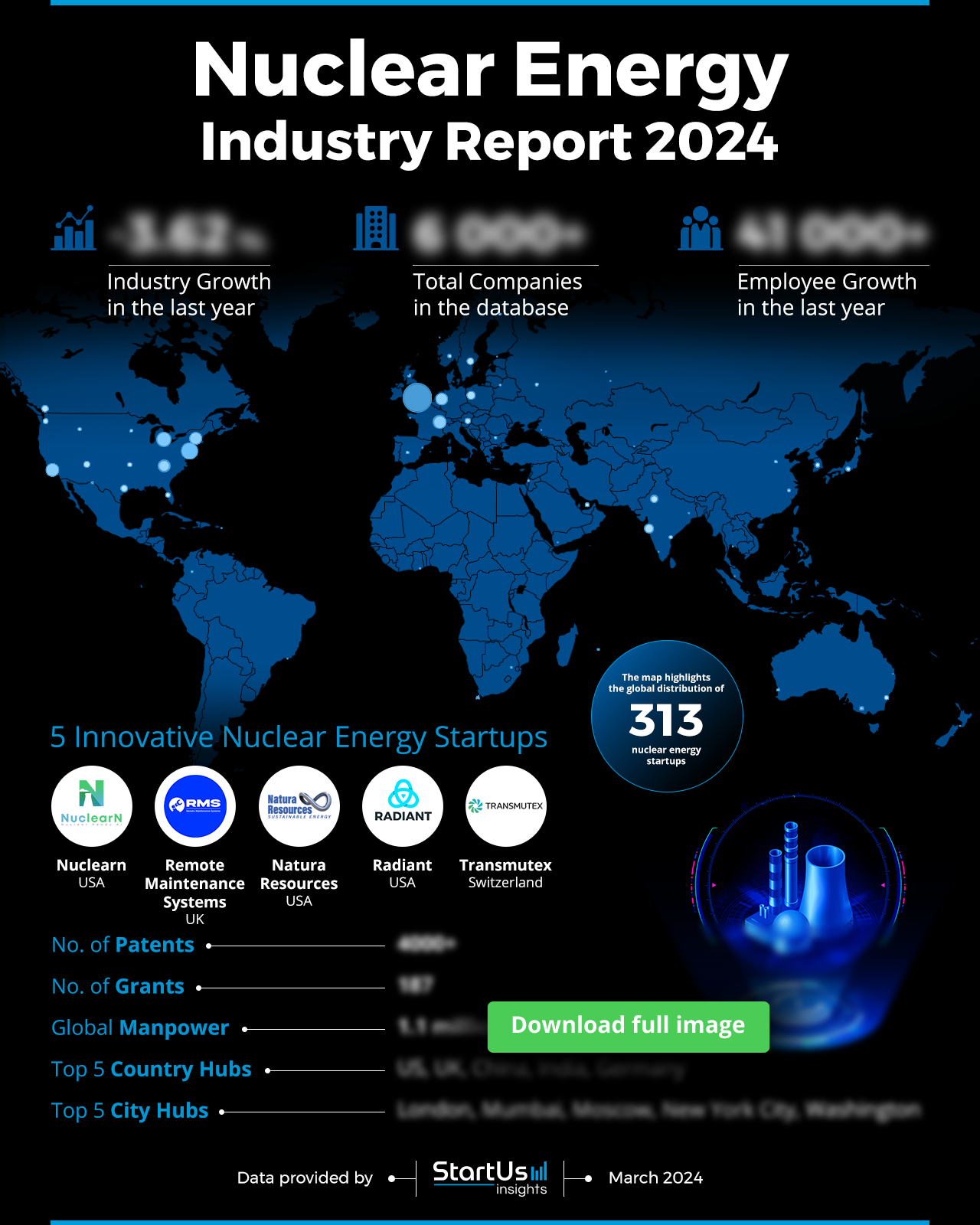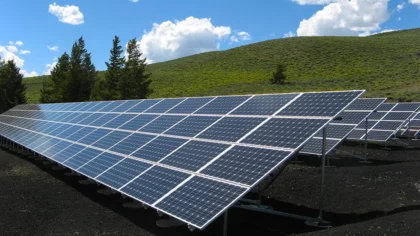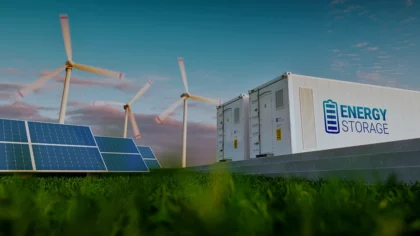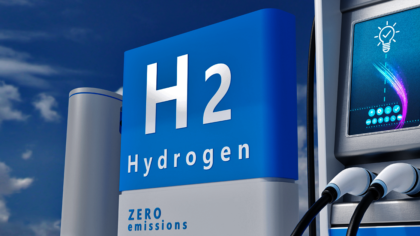The Nuclear Energy Report for 2024 provides an overview of a sector that is undergoing significant changes. Amidst a shifting global energy landscape, the nuclear industry adjusts and introduces new solutions, aiming for expansion and ecological responsibility. This report explores firmographic data, shedding light on trends such as radioactive waste management, nuclear engineering, uranium mining, and more. It also offers a detailed analysis of workforce expansion and organizational trends while showcasing five innovative startups.
This report was last updated in July 2024.
This nuclear energy industry report serves as a reference for stakeholders within the industry, investors, policymakers, and economic analysts, providing a snapshot of the industry’s health to map its trajectory for innovation and growth in the coming years.
StartUs Insights Nuclear Energy Report 2024
- Executive Summary
- Introduction to the Nuclear Energy Report 2024
- What data is used in this Nuclear Energy Report?
- Snapshot of the Global Nuclear Energy Industry
- Funding Landscape in the Nuclear Energy Industry
- Who is Investing in Nuclear Energy?
- Emerging Trends in the Nuclear Energy Industry
- 5 Nuclear Energy Startups impacting the Industry

Executive Summary: Nuclear Energy Outlook 2024
This report is created using data obtained from the Big Data and AI-powered StartUs Insights Discovery Platform, covering more than 4.7 million global companies, as well as 20K+ technologies and emerging trends. We also analyzed a sample of 300+ nuclear energy startups developing innovative solutions to present five examples from emerging nuclear energy industry trends.
- Industry Growth Overview: The nuclear industry experienced a decline of -3.62% in trend growth over the last year, with over 6000 active companies.
- Manpower & Employment Growth: Worldwide, the sector employs approximately 1.1 million people, with an increase of about 41000 workers over the past year.
- Patents & Grants: Innovative companies hold over 4000 patents, highlighting robust R&D, further supported by 187 grants.
- Global Footprint: Top hubs in the US, UK, China, India, and Germany and city hubs include London, Mumbai, Moscow, New York City, and Washington.
- Investment Landscape: It reveals an average investment value of USD 59 million per round across the industry, with more than 500 investors and over 1200 funding rounds closed.
- Top Investors: Leading investors, including OMERS Infrastructure, Wells Fargo, and more have made significant contributions, exceeding USD 1.3 billion in total.
- Startup Ecosystem: Five innovative nuclear energy startups include Nuclearn (AI applications), Remote Maintenance Systems (nuclear remote maintenance systems), Natura Resources (molten salt reactors), Radiant (microreactor technology), and Transmutex (carbon-free energy generation).
- Recommendations for Stakeholders: Address pressing challenges holding the industry back, such as radioactive waste management. Engage with new trends, such as nuclear fusion technology and small reactor technology. Track all big and small technological updates in the nuclear energy industry. Leverage the high potential for collaborative development that exists within the industry.
Explore the Data-driven Nuclear Power Industry Outlook Report for 2024
The nuclear energy report 2024 uses data from the Discovery Platform and encapsulates the key metrics that underline the sector’s dynamic growth and innovation. The sector has seen a slight decrease in growth by 3.62% over the past year, with over 6000 active companies. These companies have increased their workforce by adding more than 41000 employees in this timeframe and employ a total of 1.1 million people globally.
What data is used to create this nuclear energy report?
Based on the data provided by our Discovery Platform, we observe that the nuclear energy industry ranks among the top 5% in the following categories relative to all 20K topics in our database. These categories provide a comprehensive overview of the industry’s key metrics and inform the short-term future direction of the industry.
- News Coverage & Publications: The nuclear industry has been featured in over 400 publications in the past year.
- Funding Rounds: Our database includes data on more than 1200 funding rounds.
- Manpower: The industry employs a workforce of over 1 million, with an addition of over 41000 new employees last year.
- Patents: The industry holds over 4000 patents, demonstrating its commitment to innovation and research.
- Grants: The industry has received 187 grants, indicating its focus on research and development.
A Snapshot of the Global Nuclear Energy Industry
The nuclear industry shows steady growth and considerable influence worldwide, supported by its substantial manpower and corporate landscape. With a workforce of over 1.1 million individuals, this sector underscores its critical role in the global economy. It also provides stable employment opportunities. In the past year, the industry has added more than 41000 employees. Further, the industry includes over 6000 companies, reflecting the diverse opportunities it provides.
Explore the Funding Landscape of the Nuclear Energy Industry
The nuclear industry shows financial stability, with an average investment value reaching USD 59 million per round. This sector attracts investors with its opportunities and reflects confidence in its growth and innovation potential.
The industry has an active investor community, with over 500 stakeholders contributing to the future of energy. This engagement is further evidenced by the closure of more than 1200 funding rounds, indicating a market for capital inflow and continuous progress within the sector.
Moreover, the distribution of investment across more than 500 companies demonstrates a diversified portfolio strategy. This investment landscape supports the nuclear industry’s growth, moving towards a sustainable and technologically advanced future.
Who is Investing in Nuclear Energy?
The nuclear power industry has seen significant contributions from its investors, amounting to over USD 1.3 billion. Here’s the list of top investors:
- OMERS Infrastructure has made an investment of USD 405.2 million in a single company, indicating its strategic focus and optimism about the sector’s potential.
- Wells Fargo follows, with an investment of USD 250 million in one company, showing its commitment to promoting innovation and growth within this industry.
- Google has also made a strategic investment of USD 200 million in one company. This signals a growing interest in the future of nuclear energy for data centers.
- Deerfield has diversified its investment across three companies, with a total investment of USD 174 million.
- Toshiba Corporation has invested USD 157 million across two companies, reinforcing its commitment to the advancement of nuclear technology.
- The US Department of Energy has provided support to ten companies with USD 105.1 million, indicating governmental support for nuclear innovation.
- AMETEK’s investment of USD 78 million in three companies shows a focused approach towards encouraging technological advancements within the industry.
These investments underscore a collective belief in the nuclear industry’s role in shaping a sustainable energy future, driven by a mix of public, private, and corporate stakeholders.
Explore Firmographic Data for Nuclear Energy Trends
- Radioactive waste management plays a key role in the nuclear industry, involving 403 companies and employing 90K+ people. This segment saw an increase of 4K+ employees over the last year, with an annual trend growth rate of -1.42%.
- Nuclear engineering is a vital field within the nuclear sector, represented by 254 companies. It employs 70K+ individuals and has added 3K+ new hires in the past year, with an annual trend growth rate of -1.28%.
- Uranium mining is important for obtaining nuclear reactor fuel, with 181 companies and 16K+ employees involved. It has seen an addition of 700+ employees over the past year, despite an annual growth rate decline of -3.22%.
5 Top Examples from 300+ Innovative Nuclear Energy Startups
The five innovative startups showcased below are picked based on data including the trend they operate within and their relevance, founding year, funding status, and more. Book a demo to find promising startups, emerging trends, or industry data specific to your company’s needs and objectives.
Nuclearn offers Nuclear-specific AI
US-based startup Nuclearn utilizes AI to create tools for the nuclear sector. It offers a range of products, including Nuclearn Project Genius, Nuclearn AutoCAP Screener, Nuclearn Evaluator, Nuclearn Capitalizer, and Nuclearn Safety Analyzer. These products automate time-intensive tasks using machine learning. The startup’s platform is trained on extensive nuclear-related data. It adheres to export regulations and offers both on-premise and cloud deployment options. It features adaptable models tailored for unique datasets and operational requirements.
Remote Maintenance Systems develops Modular Tube Deployment System
UK-based startup Remote Maintenance Systems (RMS) focuses on engineering remote solutions, including methods, equipment, and automation for the nuclear sector. Its Modular Tube Deployment System facilitates access to hazardous zones via roof penetrations. It features a versatile deployment mechanism capable of navigating multiple routes and bypassing obstructions. The startup’s system operates fully from outside hazardous zones, allowing for safe recovery. It provides access to areas that were not accessible before, aiding in expedited decommissioning processes.
Natura Resources develops Deployable Molten Salt Reactors
US-based startup Natura Resources develops advanced nuclear energy technology, enhancing efficiency and safety in the nuclear industry. Its Molten Salt Reactors (MSRs) offer a clean, efficient solution, utilizing liquid fuel for increased energy output and reduced waste. These reactors operate at high temperatures, improving industrial heat applications and overall efficiency. They also produce thermal energy and electricity, aiding in water desalination and meeting the demand for fresh water.
Radiant builds Nuclear Microreactor
Radiant, a US-based startup, develops Kaleidos, a portable nuclear microreactor to replace diesel generators. This microreactor produces both electricity and heat, functions effectively over various power levels, and does not need water on-site. Helium gas is used to move heat from the reactor core, preventing radioactive leaks. The core is cooled by an air jacket using natural convection, which eases the process of regulatory approvals. The reactor uses TRISO fuel that includes ceramic-coated uranium particles, ensuring a reliable energy source that is resistant to meltdown.
Transmutex generates Carbon-free Energy
Swiss startup Transmutex focuses on updating civilian nuclear energy with an emphasis on safety and cost-effectiveness. Its technology integrates a particle accelerator with a nuclear fuel assembly to facilitate a controlled reaction. This approach allows for rapid cessation of the reaction, enhancing operational safety. The system’s design permits the use of various fuels, such as thorium, due to its subcritical nature. Further, the startup’s products address global demand for carbon-free base load power. The system also offers radioactive waste destruction, fuel breeding and fabrication, high-energy physics simulation software, and radioisotope production.
Gain Comprehensive Insights into Nuclear Energy Trends, Startups, or Technologies
The nuclear energy industry report presents a sector that is actively embracing new technologies and sustainable methods. Trends like the use of AI, the creation of small modular reactors, and improved safety measures point to a transition to a smart, sustainable, and more feasible industry solutions. Get in touch to explore all 300+ startups and scaleups, as well as all industry trends impacting nuclear energy companies.


![AI in Automotive: A Strategic Guide for Industry Leaders [2025-2030]](https://www.startus-insights.com/wp-content/uploads/2025/03/AI-in-Automotive-SharedImg-StartUs-Insights-noresize-420x236.webp)






